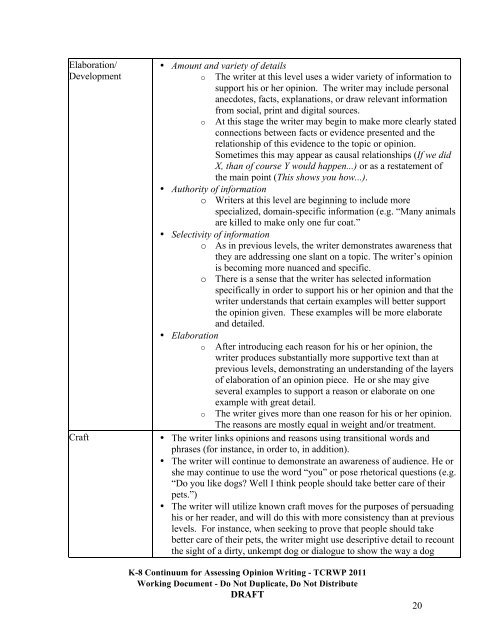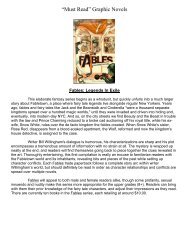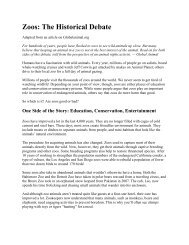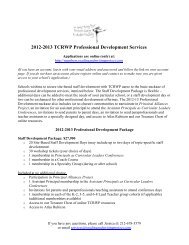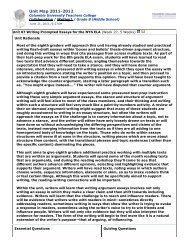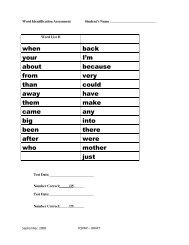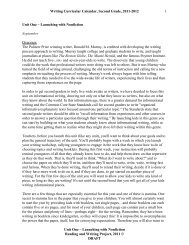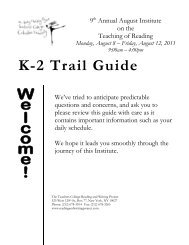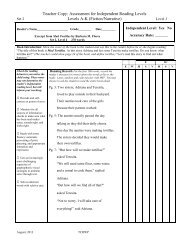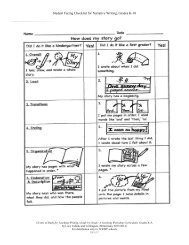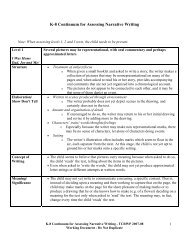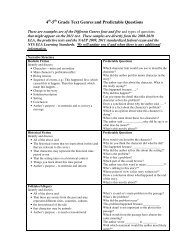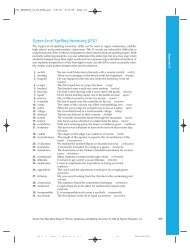Continuum for Assessing Opinion/Argument Writing - The Reading ...
Continuum for Assessing Opinion/Argument Writing - The Reading ...
Continuum for Assessing Opinion/Argument Writing - The Reading ...
You also want an ePaper? Increase the reach of your titles
YUMPU automatically turns print PDFs into web optimized ePapers that Google loves.
Elaboration/<br />
Development<br />
Craft<br />
• Amount and variety of details<br />
o <strong>The</strong> writer at this level uses a wider variety of in<strong>for</strong>mation to<br />
support his or her opinion. <strong>The</strong> writer may include personal<br />
anecdotes, facts, explanations, or draw relevant in<strong>for</strong>mation<br />
from social, print and digital sources.<br />
o<br />
At this stage the writer may begin to make more clearly stated<br />
connections between facts or evidence presented and the<br />
relationship of this evidence to the topic or opinion.<br />
Sometimes this may appear as causal relationships (If we did<br />
X, than of course Y would happen...) or as a restatement of<br />
the main point (This shows you how...).<br />
• Authority of in<strong>for</strong>mation<br />
o Writers at this level are beginning to include more<br />
specialized, domain-specific in<strong>for</strong>mation (e.g. “Many animals<br />
are killed to make only one fur coat.”<br />
• Selectivity of in<strong>for</strong>mation<br />
o As in previous levels, the writer demonstrates awareness that<br />
they are addressing one slant on a topic. <strong>The</strong> writer’s opinion<br />
is becoming more nuanced and specific.<br />
o <strong>The</strong>re is a sense that the writer has selected in<strong>for</strong>mation<br />
specifically in order to support his or her opinion and that the<br />
writer understands that certain examples will better support<br />
the opinion given. <strong>The</strong>se examples will be more elaborate<br />
and detailed.<br />
• Elaboration<br />
o After introducing each reason <strong>for</strong> his or her opinion, the<br />
writer produces substantially more supportive text than at<br />
previous levels, demonstrating an understanding of the layers<br />
of elaboration of an opinion piece. He or she may give<br />
several examples to support a reason or elaborate on one<br />
example with great detail.<br />
o<br />
<strong>The</strong> writer gives more than one reason <strong>for</strong> his or her opinion.<br />
<strong>The</strong> reasons are mostly equal in weight and/or treatment.<br />
• <strong>The</strong> writer links opinions and reasons using transitional words and<br />
phrases (<strong>for</strong> instance, in order to, in addition).<br />
• <strong>The</strong> writer will continue to demonstrate an awareness of audience. He or<br />
she may continue to use the word “you” or pose rhetorical questions (e.g.<br />
“Do you like dogs Well I think people should take better care of their<br />
pets.”)<br />
• <strong>The</strong> writer will utilize known craft moves <strong>for</strong> the purposes of persuading<br />
his or her reader, and will do this with more consistency than at previous<br />
levels. For instance, when seeking to prove that people should take<br />
better care of their pets, the writer might use descriptive detail to recount<br />
the sight of a dirty, unkempt dog or dialogue to show the way a dog<br />
K-8 <strong>Continuum</strong> <strong>for</strong> <strong>Assessing</strong> <strong>Opinion</strong> <strong>Writing</strong> - TCRWP 2011<br />
Working Document - Do Not Duplicate, Do Not Distribute<br />
DRAFT<br />
20


